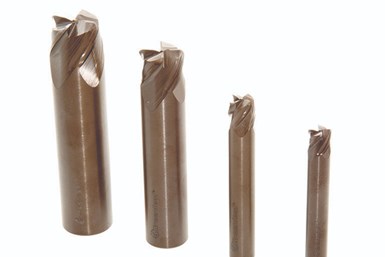Greenleaf Introduces Xsytin-360 End Mills
Greenleaf's Xsytin-360 solid ceramic end mills offer high material removal rates and increased productivity, according to the company.
Share






Greenleaf Corporation has introduced a line of solid ceramic end mills: Xsytin-360. The end mills are composed of Xsytin-1, which allows users to apply chip loads similar to solid carbide end mills with higher speeds common to ceramic machining, according to the company.
Greenleaf’s Xsytin-1 material was designed to provide high wear resistance and thermal shock resistance. According to the company, Xsytin-360 end mills have shown high material removal rates and resulted in increased productivity on a range of materials. These end mills are suitable for machining a variety of materials, including high-temperature alloys, 3D-printed sintered high-temperature alloys, hardened steels, ductile cast irons and compacted graphite iron (CGI). Greenleaf states that, in hardened steels, Xsytin-360 end mills have tool life equal to high-performance carbide end mills when run at high-end speeds (11,460 RPM), while also removing over 73 cubic inches of material.
According to Greenleaf, features include:
- A flute design that is reported to minimize cutting forces, reducing vibrations and optimizing tool life
- High strength and wear resistance at extreme feed rates
- Four-flute design for maximum material removal in slotting, pocketing and profiling applications
- Regrind capabilities
- A broad application range
- Increased feed rate capability and broad speed range
- Increased material removal rates (MRR) of 100% over carbide
The mills are suitable for machining materials in the aerospace, automotive, die and mold and power generation industries.
Related Content
-
Shoulder Milling Cuts Racing Part's Cycle Time By Over 50%
Pairing a shoulder mill with a five-axis machine has cut costs and cycle times for one of TTI Machine’s parts, enabling it to support a niche racing community.
-
The Future of High Feed Milling in Modern Manufacturing
Achieve higher metal removal rates and enhanced predictability with ISCAR’s advanced high-feed milling tools — optimized for today’s competitive global market.
-
Quick-Change Tool Heads Reduce Setup on Swiss-Type Turning Centers
This new quick-change tooling system enables shops to get more production from their Swiss turning centers through reduced tool setup time and matches the performance of a solid tool.

.JPG;width=70;height=70;mode=crop)

















.png;maxWidth=300;quality=90)

